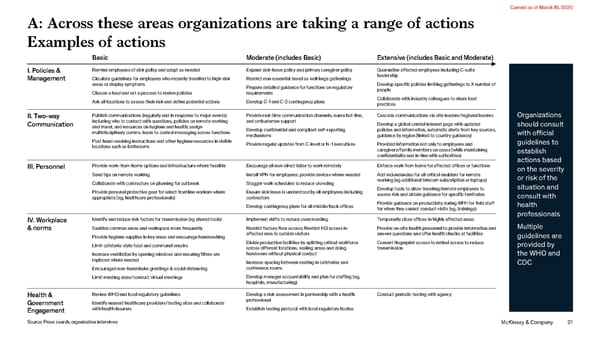Current as of March 16, 2020 A: Across these areas organizations are taking a range of actions Examples of actions Basic Moderate (includes Basic) Extensive (includes Basic and Moderate) I. Policies & Remind employees of sick policy and adapt as needed Expand sick-leave policy and primary caregiver policy Quarantine affected employees including C-suite Management Circulate guidelines for employees who recently travelled to high-risk Restrict non-essential travel as well large gatherings leadership areas or display symptoms Prepare detailed guidance for functions on regulatory Develop specific policies limiting gatherings to X number of Choose a lead and set a process to review policies requirements people Ask all locations to assess their risk and define potential actions Develop C-1 and C-2 contingency plans Collaborate with industry colleagues to share best practices II. Two-way Publish communications (regularly and in response to major events) Provide real-time communication channels, nurse hot-line, Cascade communications via site leaders/regional leaders Organizations Communication including who to contact with questions, policies on remote working and ombudsman support Develop a global central intranet page with updated should consult and travel, and resources on hygiene and health; assign Develop confidential and compliant self-reporting policies and information, automatic alerts from key sources, multidisciplinary comms. leads to control messaging across functions mechanisms guidance by region (linked to country guidance) with official Post hand-washing instructions and other hygiene resources in visible Provide regular updates from C-level or N-1 executives Provided information not only to employees and guidelines to locations such as bathrooms caregivers/family members on cases (while maintaining establish confidentiality and in-line with authorities) actions based III. Personnel Provide work-from-home options and infrastructure where feasible Encourage all non-direct labor to work remotely Enforce work from home for affected offices or functions on the severity Send tips on remote working Install VPN for employees; provide devices where needed Add redundancies for all critical enablers for remote or risk of the Collaborate with contractors on planning for outbreak Stagger work schedules to reduce crowding working (eg additional telecom subscription or laptops) Provide personal protective gear for select frontline workers where Ensure sick leave is understood by all employees including Develop tools to allow traveling/remote employees to situation and appropriate (eg, healthcare professionals) contractors assess risk and obtain guidance for specific territories consult with Develop contingency plans for all middle/back offices Provide guidance on productivity during WFH for field staff health for when they cannot conduct visits (eg, trainings) professionals IV. Workplace Identify and reduce risk factors for transmission (eg shared tools) Implement shifts to reduce overcrowding Temporarily close offices in highly affected areas & norms Sanitize common areas and workspace more frequently Restrict factory floor access; Restrict HQ access in Provide on-site health personnel to provide information and Multiple Provide hygiene supplies in key areas and encourage handwashing affected area to outside visitors answer questions and offer health checks at facilities guidelines are Limit cafeteria-style food and communal snacks Divide production facilities by splitting critical workforce Convert fingerprint access to retinal access to reduce provided by across different locations, sealing areas and doing transmission Increase ventilation by opening windows and ensuring filters are handovers without physical contact the WHO and replaced where needed Increase spacing between seating in cafeterias and CDC Encouraged non-handshake greetings & social distancing conference rooms Limit meeting sizes/conduct virtual meetings Develop manager accountability and plan for staffing (eg, hospitals, manufacturing) Health & Review WHO and local regulatory guidelines Develop a risk assessment in partnership with a health Conduct periodic testing with agency Government Identify nearest healthcare providers/testing sites and collaborate professional Engagement with health insurers Establish testing protocol with local regulatory bodies Source: Press search, organization interviews McKinsey & Company 21
 COVID-19 Facts and Insight Page 20 Page 22
COVID-19 Facts and Insight Page 20 Page 22